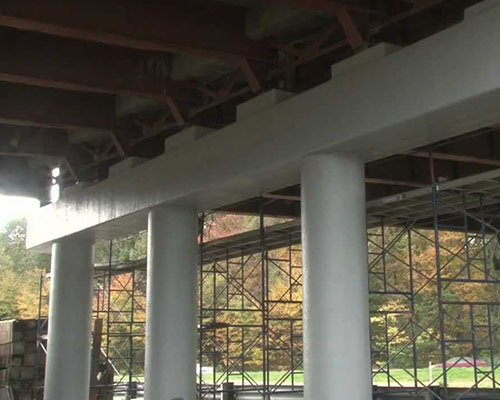

Research Reports |
| Title: | Optimal Selection of Upgrade and Maintenance Interventions to Minimize Life-Cycle Cost |
| Authors: | Moatassem Abdallah, Mehmet Ozbek, and Mahdi Ghafoori |
| University: | Colorado State University, University of Colorado Denver |
| Publication Date: | Aug 2024 |
| Report #: | MPC-24-531 |
| Project #: | MPC-676 |
| TRID #: | 01937645 |
| Keywords: | budgeting, concrete bridges, life cycle costing, linear programming, machine learning, maintenance management, optimization, predictive models |
| Type: | Research Report – MPC Publications |
 The maintenance and upgrade of infrastructure and buildings are critical for ensuring their performance, safety, and minimizing costs. However, inadequate planning and budget allocation, as well as resource constraints, often result in delayed maintenance, leading to costly interventions. To address these challenges, this study presents two novel models for optimizing the selection of upgrade and maintenance interventions to minimize the life-cycle cost while complying with annual budgets and performance requirements. The first model focuses on bridges and utilizes machine learning (ML) techniques to predict the condition of concrete bridge elements based on the National Bridge Inventory (NBI) and National Bridge Elements (NBE) databases. The model uses binary linear programming to identify the optimal selection of maintenance interventions and their timing to maximize bridge performance. The model's primary contributions are the development of a novel system that integrates ML techniques and linear programming, predicting bridge element conditions based on NBE's health index metric, and generating long-term maintenance plans to maximize the performance of bridges within available budgets. The second model focuses on buildings and proposes a computationally efficient model for identifying optimal upgrade and maintenance interventions to minimize the equivalent annual operation and maintenance cost (EAOMC) while complying with specified annual budgets and building operational performance. The model integrates reactive, preventive, and predictive maintenance strategies based on component types and incorporates simulation-based approach to evaluate energy and water consumption of buildings. The model's primary contributions are the development of a new model for identifying optimal selection of building upgrade and maintenance interventions, integrating maintenance and upgrade interventions to maximize economic benefits, and reducing operational and maintenance costs. Both models are evaluated using case studies and demonstrating new capabilities in identifying optimal upgrade and maintenance interventions for various operational budgets while achieving significant reductions in EAOMC and maximizing the performance of infrastructure and buildings. These models can assist decision-makers, such as highway agencies, in allocating limited financial resources for maintenance more efficiently and cost-effectively. The proposed approach can lead to significant economic and environmental benefits by reducing the life-cycle cost of infrastructure and buildings while ensuring their performance, safety, and sustainability.
The maintenance and upgrade of infrastructure and buildings are critical for ensuring their performance, safety, and minimizing costs. However, inadequate planning and budget allocation, as well as resource constraints, often result in delayed maintenance, leading to costly interventions. To address these challenges, this study presents two novel models for optimizing the selection of upgrade and maintenance interventions to minimize the life-cycle cost while complying with annual budgets and performance requirements. The first model focuses on bridges and utilizes machine learning (ML) techniques to predict the condition of concrete bridge elements based on the National Bridge Inventory (NBI) and National Bridge Elements (NBE) databases. The model uses binary linear programming to identify the optimal selection of maintenance interventions and their timing to maximize bridge performance. The model's primary contributions are the development of a novel system that integrates ML techniques and linear programming, predicting bridge element conditions based on NBE's health index metric, and generating long-term maintenance plans to maximize the performance of bridges within available budgets. The second model focuses on buildings and proposes a computationally efficient model for identifying optimal upgrade and maintenance interventions to minimize the equivalent annual operation and maintenance cost (EAOMC) while complying with specified annual budgets and building operational performance. The model integrates reactive, preventive, and predictive maintenance strategies based on component types and incorporates simulation-based approach to evaluate energy and water consumption of buildings. The model's primary contributions are the development of a new model for identifying optimal selection of building upgrade and maintenance interventions, integrating maintenance and upgrade interventions to maximize economic benefits, and reducing operational and maintenance costs. Both models are evaluated using case studies and demonstrating new capabilities in identifying optimal upgrade and maintenance interventions for various operational budgets while achieving significant reductions in EAOMC and maximizing the performance of infrastructure and buildings. These models can assist decision-makers, such as highway agencies, in allocating limited financial resources for maintenance more efficiently and cost-effectively. The proposed approach can lead to significant economic and environmental benefits by reducing the life-cycle cost of infrastructure and buildings while ensuring their performance, safety, and sustainability.
Abdallah, Moatassem, Mehmet Ozbek, and Mahdi Ghafoori. Optimal Selection of Upgrade and Maintenance Interventions to Minimize Life-Cycle Cost, MPC-24-531. North Dakota State University - Upper Great Plains Transportation Institute, Fargo: Mountain-Plains Consortium, 2024.